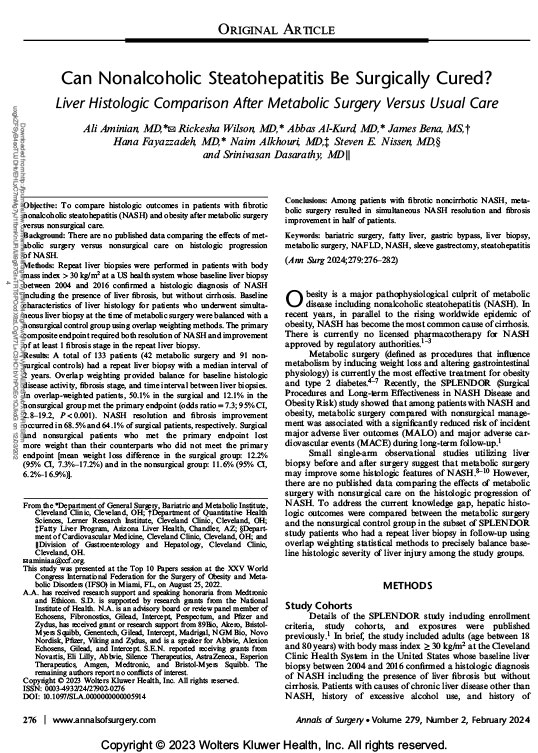Can Nonalcoholic Steatohepatitis Be Surgically Cured? Liver Histologic Comparison After Metabolic Surgery Versus Usual Care
February 2024
Annals of Surgery
Objective: To compare histologic outcomes in patients with fibrotic nonalcoholic steatohepatitis (NASH) and obesity after metabolic surgery versus nonsurgical care.
Background: There are no published data comparing the effects of metabolic surgery versus nonsurgical care on histologic progression of NASH.
Methods: Repeat liver biopsies were performed in patients with body mass index >30 kg/m2 at a US health system whose baseline liver biopsy between 2004 and 2016 confirmed a histologic diagnosis of NASH including the presence of liver fibrosis, but without cirrhosis. Baseline characteristics of liver histology for patients who underwent simultaneous liver biopsy at the time of metabolic surgery were balanced with a nonsurgical control group using overlap weighting methods. The primary composite endpoint required both resolution of NASH and improvement of at least 1 fibrosis stage in the repeat liver biopsy.
Results: A total of 133 patients (42 metabolic surgery and 91 nonsurgical controls) had a repeat liver biopsy with a median interval of 2 years. Overlap weighting provided balance for baseline histologic disease activity, fibrosis stage, and time interval between liver biopsies. In overlap-weighted patients, 50.1% in the surgical and 12.1% in the nonsurgical group met the primary endpoint (odds ratio = 7.3; 95% CI, 2.8–19.2, P < 0.001). NASH resolution and fibrosis improvement occurred in 68.5% and 64.1% of surgical patients, respectively. Surgical and nonsurgical patients who met the primary endpoint lost more weight than their counterparts who did not meet the primary endpoint [mean weight loss difference in the surgical group: 12.2% (95% CI, 7.3%–17.2%) and in the nonsurgical group: 11.6% (95% CI, 6.2%–16.9%)].

